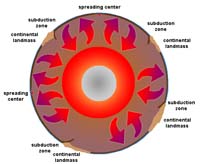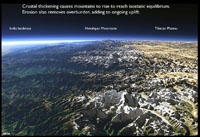3.13: The Mantle
- Page ID
- 9830
\( \newcommand{\vecs}[1]{\overset { \scriptstyle \rightharpoonup} {\mathbf{#1}} } \)
\( \newcommand{\vecd}[1]{\overset{-\!-\!\rightharpoonup}{\vphantom{a}\smash {#1}}} \)
\( \newcommand{\dsum}{\displaystyle\sum\limits} \)
\( \newcommand{\dint}{\displaystyle\int\limits} \)
\( \newcommand{\dlim}{\displaystyle\lim\limits} \)
\( \newcommand{\id}{\mathrm{id}}\) \( \newcommand{\Span}{\mathrm{span}}\)
( \newcommand{\kernel}{\mathrm{null}\,}\) \( \newcommand{\range}{\mathrm{range}\,}\)
\( \newcommand{\RealPart}{\mathrm{Re}}\) \( \newcommand{\ImaginaryPart}{\mathrm{Im}}\)
\( \newcommand{\Argument}{\mathrm{Arg}}\) \( \newcommand{\norm}[1]{\| #1 \|}\)
\( \newcommand{\inner}[2]{\langle #1, #2 \rangle}\)
\( \newcommand{\Span}{\mathrm{span}}\)
\( \newcommand{\id}{\mathrm{id}}\)
\( \newcommand{\Span}{\mathrm{span}}\)
\( \newcommand{\kernel}{\mathrm{null}\,}\)
\( \newcommand{\range}{\mathrm{range}\,}\)
\( \newcommand{\RealPart}{\mathrm{Re}}\)
\( \newcommand{\ImaginaryPart}{\mathrm{Im}}\)
\( \newcommand{\Argument}{\mathrm{Arg}}\)
\( \newcommand{\norm}[1]{\| #1 \|}\)
\( \newcommand{\inner}[2]{\langle #1, #2 \rangle}\)
\( \newcommand{\Span}{\mathrm{span}}\) \( \newcommand{\AA}{\unicode[.8,0]{x212B}}\)
\( \newcommand{\vectorA}[1]{\vec{#1}} % arrow\)
\( \newcommand{\vectorAt}[1]{\vec{\text{#1}}} % arrow\)
\( \newcommand{\vectorB}[1]{\overset { \scriptstyle \rightharpoonup} {\mathbf{#1}} } \)
\( \newcommand{\vectorC}[1]{\textbf{#1}} \)
\( \newcommand{\vectorD}[1]{\overrightarrow{#1}} \)
\( \newcommand{\vectorDt}[1]{\overrightarrow{\text{#1}}} \)
\( \newcommand{\vectE}[1]{\overset{-\!-\!\rightharpoonup}{\vphantom{a}\smash{\mathbf {#1}}}} \)
\( \newcommand{\vecs}[1]{\overset { \scriptstyle \rightharpoonup} {\mathbf{#1}} } \)
\(\newcommand{\longvect}{\overrightarrow}\)
\( \newcommand{\vecd}[1]{\overset{-\!-\!\rightharpoonup}{\vphantom{a}\smash {#1}}} \)
\(\newcommand{\avec}{\mathbf a}\) \(\newcommand{\bvec}{\mathbf b}\) \(\newcommand{\cvec}{\mathbf c}\) \(\newcommand{\dvec}{\mathbf d}\) \(\newcommand{\dtil}{\widetilde{\mathbf d}}\) \(\newcommand{\evec}{\mathbf e}\) \(\newcommand{\fvec}{\mathbf f}\) \(\newcommand{\nvec}{\mathbf n}\) \(\newcommand{\pvec}{\mathbf p}\) \(\newcommand{\qvec}{\mathbf q}\) \(\newcommand{\svec}{\mathbf s}\) \(\newcommand{\tvec}{\mathbf t}\) \(\newcommand{\uvec}{\mathbf u}\) \(\newcommand{\vvec}{\mathbf v}\) \(\newcommand{\wvec}{\mathbf w}\) \(\newcommand{\xvec}{\mathbf x}\) \(\newcommand{\yvec}{\mathbf y}\) \(\newcommand{\zvec}{\mathbf z}\) \(\newcommand{\rvec}{\mathbf r}\) \(\newcommand{\mvec}{\mathbf m}\) \(\newcommand{\zerovec}{\mathbf 0}\) \(\newcommand{\onevec}{\mathbf 1}\) \(\newcommand{\real}{\mathbb R}\) \(\newcommand{\twovec}[2]{\left[\begin{array}{r}#1 \\ #2 \end{array}\right]}\) \(\newcommand{\ctwovec}[2]{\left[\begin{array}{c}#1 \\ #2 \end{array}\right]}\) \(\newcommand{\threevec}[3]{\left[\begin{array}{r}#1 \\ #2 \\ #3 \end{array}\right]}\) \(\newcommand{\cthreevec}[3]{\left[\begin{array}{c}#1 \\ #2 \\ #3 \end{array}\right]}\) \(\newcommand{\fourvec}[4]{\left[\begin{array}{r}#1 \\ #2 \\ #3 \\ #4 \end{array}\right]}\) \(\newcommand{\cfourvec}[4]{\left[\begin{array}{c}#1 \\ #2 \\ #3 \\ #4 \end{array}\right]}\) \(\newcommand{\fivevec}[5]{\left[\begin{array}{r}#1 \\ #2 \\ #3 \\ #4 \\ #5 \\ \end{array}\right]}\) \(\newcommand{\cfivevec}[5]{\left[\begin{array}{c}#1 \\ #2 \\ #3 \\ #4 \\ #5 \\ \end{array}\right]}\) \(\newcommand{\mattwo}[4]{\left[\begin{array}{rr}#1 \amp #2 \\ #3 \amp #4 \\ \end{array}\right]}\) \(\newcommand{\laspan}[1]{\text{Span}\{#1\}}\) \(\newcommand{\bcal}{\cal B}\) \(\newcommand{\ccal}{\cal C}\) \(\newcommand{\scal}{\cal S}\) \(\newcommand{\wcal}{\cal W}\) \(\newcommand{\ecal}{\cal E}\) \(\newcommand{\coords}[2]{\left\{#1\right\}_{#2}}\) \(\newcommand{\gray}[1]{\color{gray}{#1}}\) \(\newcommand{\lgray}[1]{\color{lightgray}{#1}}\) \(\newcommand{\rank}{\operatorname{rank}}\) \(\newcommand{\row}{\text{Row}}\) \(\newcommand{\col}{\text{Col}}\) \(\renewcommand{\row}{\text{Row}}\) \(\newcommand{\nul}{\text{Nul}}\) \(\newcommand{\var}{\text{Var}}\) \(\newcommand{\corr}{\text{corr}}\) \(\newcommand{\len}[1]{\left|#1\right|}\) \(\newcommand{\bbar}{\overline{\bvec}}\) \(\newcommand{\bhat}{\widehat{\bvec}}\) \(\newcommand{\bperp}{\bvec^\perp}\) \(\newcommand{\xhat}{\widehat{\xvec}}\) \(\newcommand{\vhat}{\widehat{\vvec}}\) \(\newcommand{\uhat}{\widehat{\uvec}}\) \(\newcommand{\what}{\widehat{\wvec}}\) \(\newcommand{\Sighat}{\widehat{\Sigma}}\) \(\newcommand{\lt}{<}\) \(\newcommand{\gt}{>}\) \(\newcommand{\amp}{&}\) \(\definecolor{fillinmathshade}{gray}{0.9}\)Mantle Convection
Gravitational heat convection in the mantle is the source of forces that move, bend, and break rocks in the Earth's lithosphere (Figure 3.19). Heat in the Earth is produced by radioactive decay of unstable isotopes as well as heat left over from when the Earth formed billions of years ago in the solar system's nebula.
Motion within the mantle is responsible for deep crustal stretching (extension) and compression. Motion in the mantle is produced by gravitational heat convection—hot rocks expand and rise whereas cooler (hence denser) rocks sink. Thicker, less dense, continental crust floats higher than thinner, denser ocean crust below ocean basins. Gravity-driven heat convection within the Earth is the conclusive power source driving plate tectonic motions.

Figure 3.19. Mantle convection is the driving force of movement in the Earth's lithosphere.
Behavior of the Lithosphere (rigid crust and upper mantle) and Asthenosphere (upper mantle)
Subdivisions used in geologic discussions relating to Plate Tectonics Theory (discussed below) include:
The Lithosphere is the rocky outer portion of the Earth, consist of the crust and upper mantle (about the upper 60 miles [100 km] below the Earth's surface). It is the solid (more brittle) zone of the earth where earthquakes occur.
The asthenosphere is the upper portion of the mantle underlying the lithosphere where heat and pressure is great enough for materials to flow slowly. This movement is driven by the heat derived from within the deeper parts of the mantle and core that cause materials to flow by gravitational heat convection (see Figure 3.19). Gravitational convection works as follows—Adding heat causes materials (solid and molten) to expand, loose density, and rise; whereas cooling material shrinks and increases in density, and sinks. The asthenosphere is a semi fluid layer of the Earth, between about 40 to 80 miles (100-200 km) below the outer rigid lithosphere (oceanic and continental crust) forming part of the mantle and thought to be able to slowly flow vertically and horizontally, enabling sections of lithosphere to subside, rise, and undergo lateral movement associated with plate tectonics.
Another important distinction within the lithosphere are the differences between what is known as oceanic crust and continental crust. The rocks exposed on continental land masses are different than those found in the crust beneath the ocean basins.
Ocean crust is part of Earth's lithosphere that underlies ocean basins. Oceanic crust is primarily composed of mafic rocks (chiefly basalt and other rocks rich in iron and magnesium). These rocks are more dense than the rocks that underlie continents (continental crust rocks are less dense and are enriched in silica and aluminum). In addition, ocean crust around the world is significantly younger (less than 200 million years). In contrast, rocks that are found within continental landmasses are generally less dense and much older than rocks found beneath ocean basins. Land masses composed of continental crust have typically accumulated very slowly through the natural refining processes associated with plate-tectonics over many hundreds of millions to several billion years.
Continental crust is the relatively thick parts of the Earth's crust that forms the large landmasses. Continental crust is generally older, thicker, and less dense than ocean crust. Continental crust is also typically, more complex than oceanic crust, Continental landmasses are dominantly composed of igneous and metamorphic of granite or more felsic composition (rocks are enriched in silica and aluminum).
In general, rocks found within continental crust are less dense and thicker than the rocks beneath the ocean basins. This difference in thickness and density of the two types of crust helps explain the geography of the planet as well as explaining many aspects of the tectonic forces changing the landscapes of our planet over time. Just like blocks of wood floating in water, where the continental crust is thicker and less dense, the land masses isostatically float higher on the asthenosphere. Where the continental crust is thick enough it rise above the surface of the oceans (Figure 3.20). Oceans fills in the lower regions on the Earth's surface underlain by thinner, denser ocean crust.




